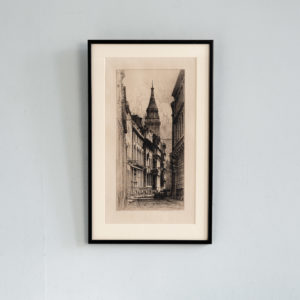951 items found
Page 2 of 10
-
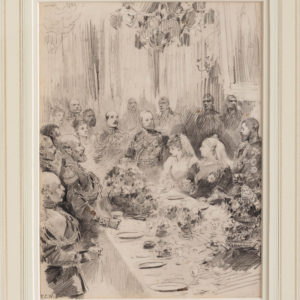
“Wedding Breakfast of the Future King George V” by Richard Caton Woodville Jr.
£495“Wedding Breakfast of the Future King George V” by Richard Caton Woodville Jr.
Richard Caton Woodville Jr. RI. ROI. (7 January 1856 – 17 August 1927) was an English artist and illustrator, was best known his historical battle scenes in the late 19th and early 20th centuries. Woodville spent most of his career working for the Illustrated London News, where he quickly developed a reputation as a talented reporter and writer.£495 -
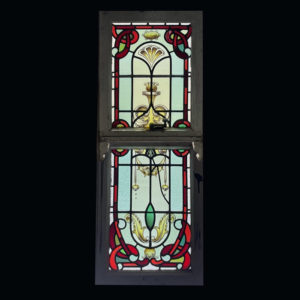
An attractive narrow Victorian double-hung stained glass sash window
£495 the two sashesAn attractive narrow Victorian double-hung stained glass sash window
each rectangular pine sash with leaded polychrome glass painted with a stylised foliate ornament and a scarlet ribbon border - the design uniting the two windows,£495 the two sashes -
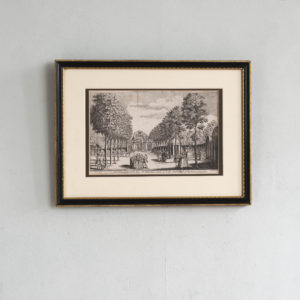
The Triumphal Arches, Mr. Handel’s Statue & c. in the South Walk of Vauxhall Gardens
£495The Triumphal Arches, Mr. Handel’s Statue & c. in the South Walk of Vauxhall Gardens
Based on the work by Samuel Wale and engraved by Benjamin Cole in 1752. Mounted and presented in a Hogarth style frame.£495 -

“Progress IV” artists screenprint by Anthony Benjamin (1931 – 2002)
£480“Progress IV” artists screenprint by Anthony Benjamin (1931 – 2002)
Anthony Benjamin (29 March 1931 – 17 February 2002) FRSA, RE was an English painter, sculptor and printmaker. Benjamin was a fellow of the Royal Society of Arts (FRSA) and a member of the Royal Society of Painter-Printmakers (RE)£480 -
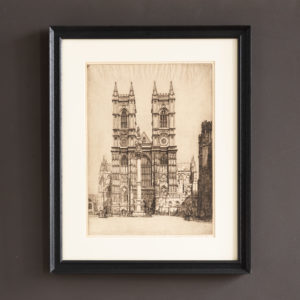
Westminster Abbey by Mortimer Mempes
£480Westminster Abbey by Mortimer Mempes
Mortimer Luddington Menpes. Printmaker, painter of genre, architectural subjects, and writer was born in Alelaide, Australia and came to England c.1875 where he remained until his death in 1938.£480 -
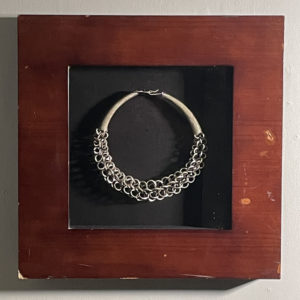
A framed Miao ceremonial necklace
£465A framed Miao ceremonial necklace
the finely wrapped silver-wire, tapering behind the neck where it is hooked and expanding across the collar into interwoven loops, presented in a 20th Century veneered glazed display frame,£465 -
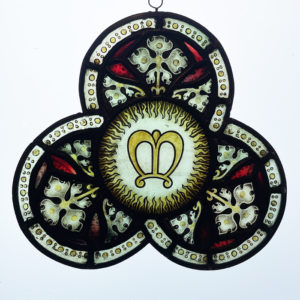
A Victorian leaded stained glass trefoil hanger,
£460A Victorian leaded stained glass trefoil hanger,
the trefoil light centred with a gothic "M" in a sunburst, the lobes painted with foliate ornament, chain hung from wire loops,£460 -
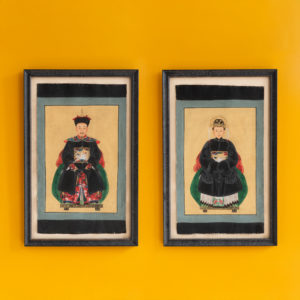
Chinese Ancestor Portraits
£450 the pairChinese Ancestor Portraits
Ancestor portraits form an important part of the Chinese practice of ancestor worship, created as near life size likenesses of the deceased. Families would honour and commemorate their ancestors, carrying out rituals and giving offerings.£450 the pair -
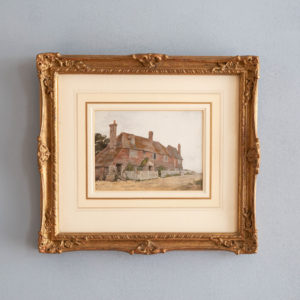
Cottages by Croydon born artist, George Edward Handel Lucas.
£450Cottages by Croydon born artist, George Edward Handel Lucas.
Original painting c1880 by George Edward Handel Lucas. Presented in a washline mount with a centre and corner gilt frame.£450 -
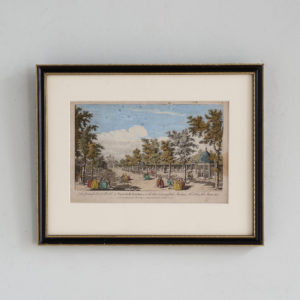
The Grand South Walk in Vaux-Hall Gardens, with the Triumphal Arches, Mr Handels Statue, &c.
£450 -
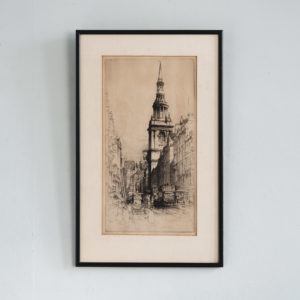
Sydney R Jones, St. Mary le Bow, Cheapside,
£450Sydney R Jones, St. Mary le Bow, Cheapside,
A mounted, framed and signed etching by the English artist Sydney R Jones (1881-1966) depicting the church of St Mary le Bow on Cheapside, London. Hand signed by the artist in pencil, bottom left, with a note that it is the '5th state' of the etching.£450 -
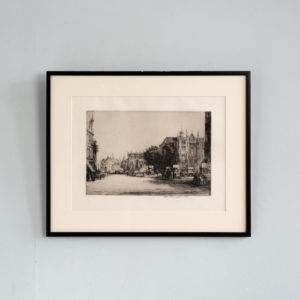
Nathaniel Sparks, Westminster from the Horseguards,
£450Nathaniel Sparks, Westminster from the Horseguards,
Mounted and in its original frame, an original dry-point engraving by the artist and painter-etcher Nathaniel Sparks showing the North Door and Lady Chapel of Westminster Abbey viewed across Parliament Square. Signed proof impression from the only edition.£450 -
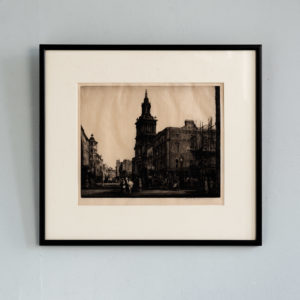
Nathaniel Sparks, St. Botolphs Church,
£450Nathaniel Sparks, St. Botolphs Church,
Mounted and in its original frame, an original dry-point engraving by the artist and painter-etcher Nathaniel Sparks showing St Botolph's church on Bishopsgate in the City of London. The corner building in the middle foreground is the White Hart Inn which had existed as a hostelry continuously on the site since 1377 until it was closed for commercial redevelopment in 2014. Signed by the artist.£450 -
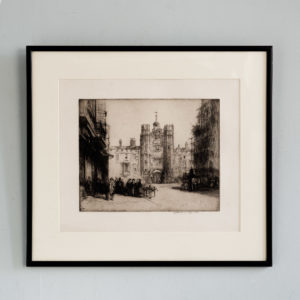
Nathaniel Sparks, St. James Palace,
£450Nathaniel Sparks, St. James Palace,
Mounted and in its original frame, an original dry-point engraving by the artist and painter-etcher Nathaniel Sparks showing the north gatehouse of St James's Palace viewed across Pall Mall from the east side of St James's Street. Signed by the artist.£450 -
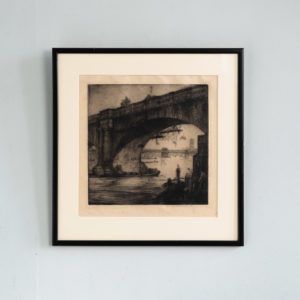
Nathaniel Sparks, Waterloo Bridge,
£450Nathaniel Sparks, Waterloo Bridge,
Mounted and in its original frame, an original dry-point engraving by the artist and painter-etcher Nathaniel Sparks showing the northernmost arch of Old Waterloo Bridge with Charing Cross and Westminster bridges beyond and the Palace of Westminster in the distance. Signed by the artist.£450 -
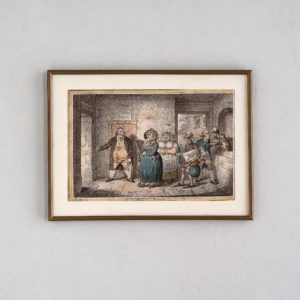
Old Maid on a Journey,
£450Old Maid on a Journey,
An original framed hand-coloured etching and engraving by caricaturist James Gillray. The corpulent figure of the independent polymath, antiquarian and collector Miss Sarah Sophia Banks is depicted being shown into the best bedroom of an Inn followed by a grotesque retinue of gurning servants carrying her assorted baggage. Miss Banks was a prolific collector of printed emphemera including broadsheets, newspaper clippings, visiting cards, caricatures, advertisements and playbills as well as being a leading numismatist of her day. Her great library of volumes on ancient coins as well as her capacious collection of the coins themselves was gifted to the nation upon her death and are now spread over the Royal Mint, The British Library and British Museum. One of the 18th Century's brilliant but unacknowledged women, Sarah Banks was the sister of the famous botanist Joseph Banks who sailed with Captain Cook to New South Wales. According to recent scholarship as well as editing her brother's manuscripts she often conversed with him on their subjects and many of her ideas were incorporated into his writings. Perhaps puzzlingly, given the warm and close friendship which was said to exist between Gillray and his wealthy female patron, Miss Banks is depicted as a obscenely fat and ugly. One can only speculate on the nature of the comedy and manners of the time (not to mention the sense of humour of the subject) when interpreting the comic effect of this print.£450 -
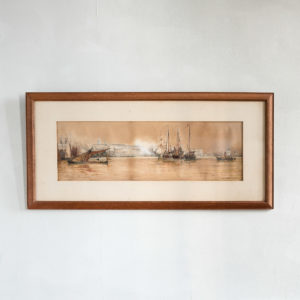
The Customs House by Thomas Bush Hardy
£450The Customs House by Thomas Bush Hardy
Showing the Pool of London with the Customs House. Signed, framed in dark wood.£450 -
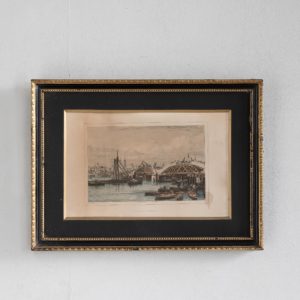
The Works of New London Bridge by Edward William Cooke RA,
£450The Works of New London Bridge by Edward William Cooke RA,
A hand-coloured engraving by George Cooke of a drawing by his son Edward William Cooke RA, from 'The Works of New London Bridge'. In 1800 it was first proposed that the inconvenient medieval bulk of old London bridge should be removed to ease traffic on the Thames and a competition was held to design a replacement. In 1824, the plans of the engineer Sir John Rennie were accepted and a site was chosen 180 feet west of the old bridge. On June 15, 1825, the Lord Mayor of London, John Garratt, laid the first block of Dartmoor granite in the presence of the Duke of York. For a short time Londoners were able to view both the old bridge and the new side-by-side. It was to be a structure of 5 arches, over 928 feet long and 49 feet wide. When the new bridge was finished and opened by King William and Queen Adelaide in 1831, traffic switched to the huge new structure and the demolition commenced on the old bridge. Edward William Cooke (1811 - 1880) was a draughtsman, illustrator, wood engraver, etcher and painter of rural and coastal scenes in oil and watercolour. In this print Cooke shows new London bridge in the middle stages of construction with the forms for the arches still in place. On the far bank of the Thames the viewer can see the Fishmongers Hall, the steeple of St Magnus the Matryr church and The Monument.£450 -
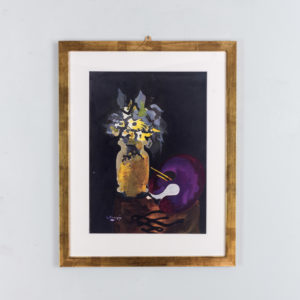
George Braque lithograph published for Verve, vol. VIII No 31/32
£450 eachGeorge Braque lithograph published for Verve, vol. VIII No 31/32
Original lithograph, published 1955 for Verve, vol. VIII No 31/32, The Intimate Sketchbooks of G. Braque. Gilt framed.£450 each -
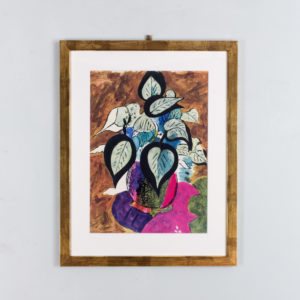
George Braque lithograph published for Verve, vol. VIII No 31/32
£450 eachGeorge Braque lithograph published for Verve, vol. VIII No 31/32
Original lithograph, published 1955 for Verve, vol. VIII No 31/32, The Intimate Sketchbooks of G. Braque. Gilt framed.£450 each -
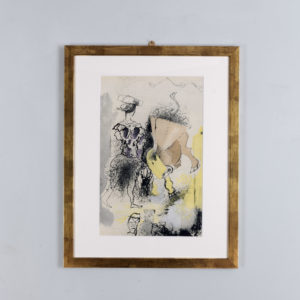
George Braque lithograph published for Verve, vol. VIII No 31/32
£450 eachGeorge Braque lithograph published for Verve, vol. VIII No 31/32
Original lithograph, published 1955 for Verve, vol. VIII No 31/32, The Intimate Sketchbooks of G. Braque. Gilt framed.£450 each -
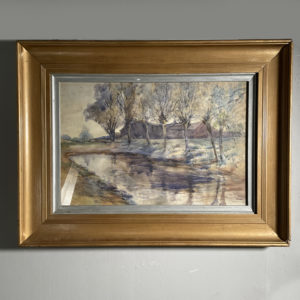
Pollarded Willows by Ernest R Fox (1883-1919)
£440Pollarded Willows by Ernest R Fox (1883-1919)
depicting a row of trees by a pond with farm buildings in the background£440 -
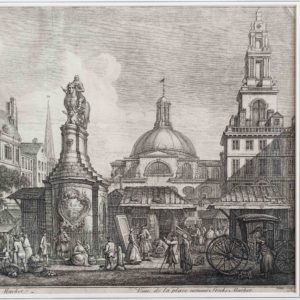
The Stocks Market,
£425The Stocks Market,
A mounted and gilt framed engracing depicting the Stocks Market in the City of London by Henry Fletcher after the painting by Joseph Nicholls. The Stocks Market existed between 1282 and 1737 on the current site of the Mansion House and has given it's name to the Bourses of the English speaking world. The statue, of Charles II trampling Oliver Cromwell underoot was the subject of a satirical verse from the pen of Andrew Marvell: "But a market, as some say, doth fit the King well, Who the Parliament too — and revenue doth sell; And others, to make the similitude hold. Say his Majesty too — is oft purchased and sold."£425 -
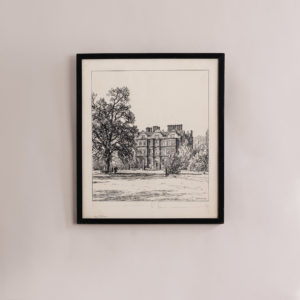
Kew Palace by Hubert Williams (1905-1989)
£425Kew Palace by Hubert Williams (1905-1989)
Kew Palace. Hubert Williams was an accomplished artist and illustrator who had the confidence to include the detail of everyday life in his views. Signed. Framed£425 -
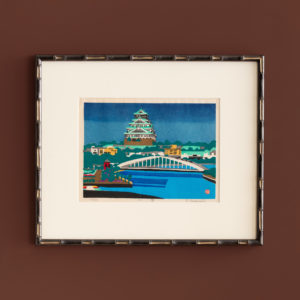
Osaka Castle (大阪城)
£420Osaka Castle (大阪城)
Born in Kobe 1923, Yuzaburo started studying woodblock print making with his father when he was eight years old. At the age of nineteen, his skill was such that he exhibited at the 11th Nihon Hanga Kyōkai (Japan Print Association) exhibition, winning a first prize, but it was not until he graduated from Kwansei Gakuin University in 1947, an education that was interrupted by the 1942 wartime Student Mobilization Order., that he became a full-time print maker. After the death of his father in 1965, Yūzaburō was to go on to become a leader in the creative print genre (sosaku hanga) in the Kansai region. was a member of Japan Print Association and a member of Kokuga Association£420 -
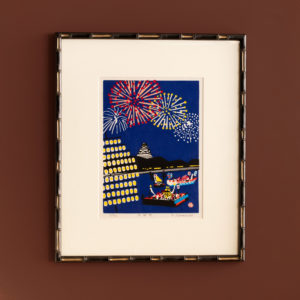
Tenjin Festival (天神祭)
£420Tenjin Festival (天神祭)
Born in Kobe 1923, Yuzaburo started studying woodblock print making with his father when he was eight years old. At the age of nineteen, his skill was such that he exhibited at the 11th Nihon Hanga Kyōkai (Japan Print Association) exhibition, winning a first prize, but it was not until he graduated from Kwansei Gakuin University in 1947, an education that was interrupted by the 1942 wartime Student Mobilization Order., that he became a full-time print maker. After the death of his father in 1965, Yūzaburō was to go on to become a leader in the creative print genre (sosaku hanga) in the Kansai region. was a member of Japan Print Association and a member of Kokuga Association£420 -

Kittens and Rabbits
£420 -
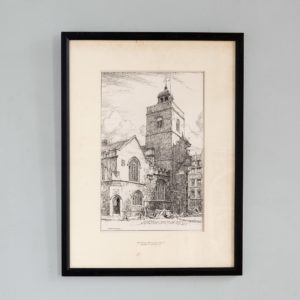
All Hallows, Barking by the Tower by Hubert Williams (1905-1989)
£420All Hallows, Barking by the Tower by Hubert Williams (1905-1989)
All Hallows, Barking by the Tower. Hubert Williams was an accomplished artist and illustrator who had the confidence to include the detail of everyday life in his views. Signed. Framed£420 -
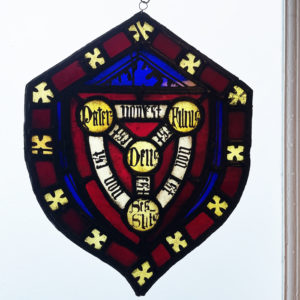
The Trinity Shield, a leaded stained glass hanger,
£415The Trinity Shield, a leaded stained glass hanger,
a shield shaped light centred with the pictogram of the Holy Trinity, the central shield centred with a "Deus" with "Est" bars linking to "Pater", "Filius" and "Sis Sits" (Spiritus Sanctus), "Non Est" linking the outer three, on a claret and indigo ground - the highlights in cadmium, hung from wire loops,£415 -
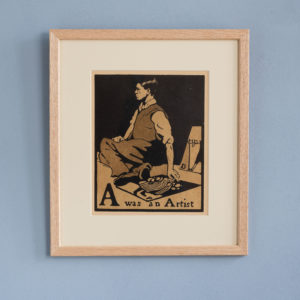
An Alphabet by William Nicholson, A was an Artist,
£400 eachAn Alphabet by William Nicholson, A was an Artist,
Nicholson was recommended by his friend, James McNeil Whistler to the publishers Heinemann as an original and expert wood-cut artist. The relationship with the publisher was highly successful, establishing Nicholson’s reputation as an illustrator. Between 1897 and 1900 he illustrated five works: An Alphabet, An Almanac of Twelve Sports, Twelve Portraits, London Types, and The Square Book of Animals.£400 each -
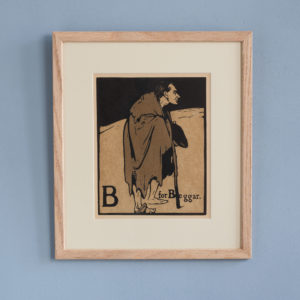
An Alphabet by William Nicholson, B for Beggar,
£400 eachAn Alphabet by William Nicholson, B for Beggar,
Nicholson was recommended by his friend, James McNeil Whistler to the publishers Heinemann as an original and expert wood-cut artist. The relationship with the publisher was highly successful, establishing Nicholson’s reputation as an illustrator. Between 1897 and 1900 he illustrated five works: An Alphabet, An Almanac of Twelve Sports, Twelve Portraits, London Types, and The Square Book of Animals.£400 each -
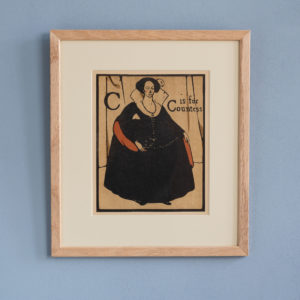
An Alphabet by William Nicholson, C is for Countess,
£400 eachAn Alphabet by William Nicholson, C is for Countess,
Nicholson was recommended by his friend, James McNeil Whistler to the publishers Heinemann as an original and expert wood-cut artist. The relationship with the publisher was highly successful, establishing Nicholson’s reputation as an illustrator. Between 1897 and 1900 he illustrated five works: An Alphabet, An Almanac of Twelve Sports, Twelve Portraits, London Types, and The Square Book of Animals.£400 each -
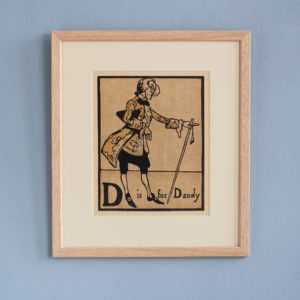
An Alphabet by William Nicholson, D is for Dandy,
£400 eachAn Alphabet by William Nicholson, D is for Dandy,
Nicholson was recommended by his friend, James McNeil Whistler to the publishers Heinemann as an original and expert wood-cut artist. The relationship with the publisher was highly successful, establishing Nicholson’s reputation as an illustrator. Between 1897 and 1900 he illustrated five works: An Alphabet, An Almanac of Twelve Sports, Twelve Portraits, London Types, and The Square Book of Animals.£400 each -
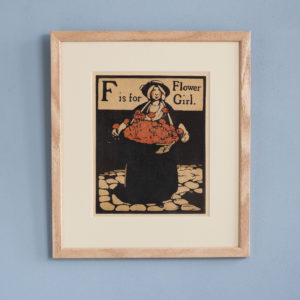
An Alphabet by William Nicholson, F is for Flower Girl,
£400 eachAn Alphabet by William Nicholson, F is for Flower Girl,
Nicholson was recommended by his friend, James McNeil Whistler to the publishers Heinemann as an original and expert wood-cut artist. The relationship with the publisher was highly successful, establishing Nicholson’s reputation as an illustrator. Between 1897 and 1900 he illustrated five works: An Alphabet, An Almanac of Twelve Sports, Twelve Portraits, London Types, and The Square Book of Animals.£400 each -
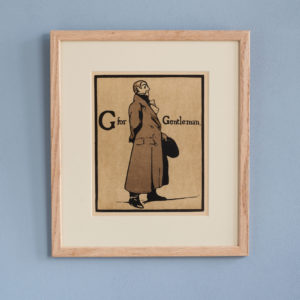
An Alphabet by William Nicholson, G for Gentleman,
£400 eachAn Alphabet by William Nicholson, G for Gentleman,
Nicholson was recommended by his friend, James McNeil Whistler to the publishers Heinemann as an original and expert wood-cut artist. The relationship with the publisher was highly successful, establishing Nicholson’s reputation as an illustrator. Between 1897 and 1900 he illustrated five works: An Alphabet, An Almanac of Twelve Sports, Twelve Portraits, London Types, and The Square Book of Animals.£400 each -

An Alphabet by William Nicholson, H for Huntsman,
£400 eachAn Alphabet by William Nicholson, H for Huntsman,
Nicholson was recommended by his friend, James McNeil Whistler to the publishers Heinemann as an original and expert wood-cut artist. The relationship with the publisher was highly successful, establishing Nicholson’s reputation as an illustrator. Between 1897 and 1900 he illustrated five works: An Alphabet, An Almanac of Twelve Sports, Twelve Portraits, London Types, and The Square Book of Animals.£400 each -
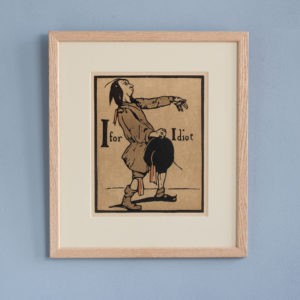
An Alphabet by William Nicholson, I for Idiot,
£400 eachAn Alphabet by William Nicholson, I for Idiot,
Nicholson was recommended by his friend, James McNeil Whistler to the publishers Heinemann as an original and expert wood-cut artist. The relationship with the publisher was highly successful, establishing Nicholson’s reputation as an illustrator. Between 1897 and 1900 he illustrated five works: An Alphabet, An Almanac of Twelve Sports, Twelve Portraits, London Types, and The Square Book of Animals.£400 each -
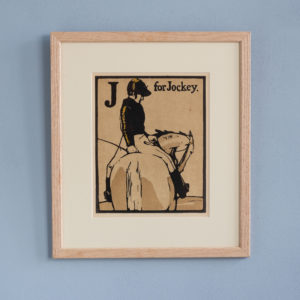
An Alphabet by William Nicholson, J for Jockey,
£400 eachAn Alphabet by William Nicholson, J for Jockey,
Nicholson was recommended by his friend, James McNeil Whistler to the publishers Heinemann as an original and expert wood-cut artist. The relationship with the publisher was highly successful, establishing Nicholson’s reputation as an illustrator. Between 1897 and 1900 he illustrated five works: An Alphabet, An Almanac of Twelve Sports, Twelve Portraits, London Types, and The Square Book of Animals.£400 each -
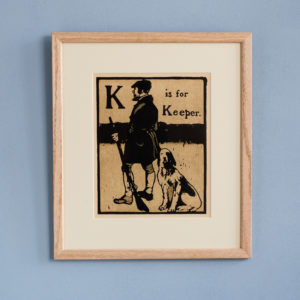
An Alphabet by William Nicholson, K is for Keeper,
£400 eachAn Alphabet by William Nicholson, K is for Keeper,
Nicholson was recommended by his friend, James McNeil Whistler to the publishers Heinemann as an original and expert wood-cut artist. The relationship with the publisher was highly successful, establishing Nicholson’s reputation as an illustrator. Between 1897 and 1900 he illustrated five works: An Alphabet, An Almanac of Twelve Sports, Twelve Portraits, London Types, and The Square Book of Animals.£400 each -
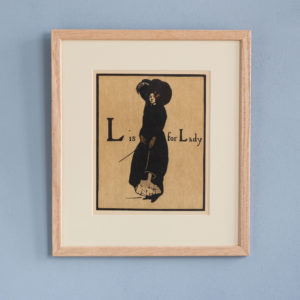
An Alphabet by William Nicholson, L is for Lady,
£400 eachAn Alphabet by William Nicholson, L is for Lady,
Nicholson was recommended by his friend, James McNeil Whistler to the publishers Heinemann as an original and expert wood-cut artist. The relationship with the publisher was highly successful, establishing Nicholson’s reputation as an illustrator. Between 1897 and 1900 he illustrated five works: An Alphabet, An Almanac of Twelve Sports, Twelve Portraits, London Types, and The Square Book of Animals.£400 each -
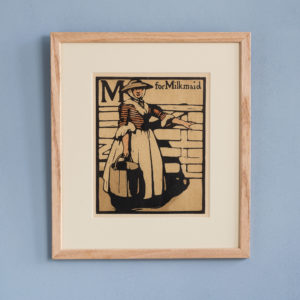
An Alphabet by William Nicholson, M for Milkmaid,
£400 eachAn Alphabet by William Nicholson, M for Milkmaid,
Nicholson was recommended by his friend, James McNeil Whistler to the publishers Heinemann as an original and expert wood-cut artist. The relationship with the publisher was highly successful, establishing Nicholson’s reputation as an illustrator. Between 1897 and 1900 he illustrated five works: An Alphabet, An Almanac of Twelve Sports, Twelve Portraits, London Types, and The Square Book of Animals.£400 each -
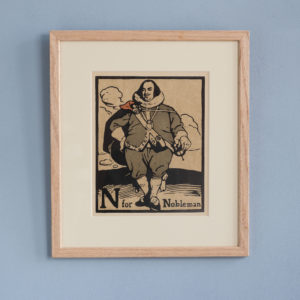
An Alphabet by William Nicholson, N for Nobleman,
£400 eachAn Alphabet by William Nicholson, N for Nobleman,
Nicholson was recommended by his friend, James McNeil Whistler to the publishers Heinemann as an original and expert wood-cut artist. The relationship with the publisher was highly successful, establishing Nicholson’s reputation as an illustrator. Between 1897 and 1900 he illustrated five works: An Alphabet, An Almanac of Twelve Sports, Twelve Portraits, London Types, and The Square Book of Animals.£400 each -
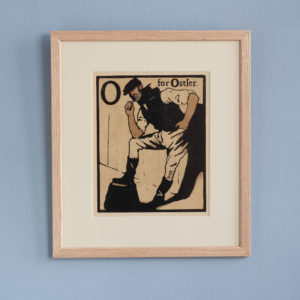
An Alphabet by William Nicholson, O for Ostler,
£400 eachAn Alphabet by William Nicholson, O for Ostler,
Nicholson was recommended by his friend, James McNeil Whistler to the publishers Heinemann as an original and expert wood-cut artist. The relationship with the publisher was highly successful, establishing Nicholson’s reputation as an illustrator. Between 1897 and 1900 he illustrated five works: An Alphabet, An Almanac of Twelve Sports, Twelve Portraits, London Types, and The Square Book of Animals.£400 each -
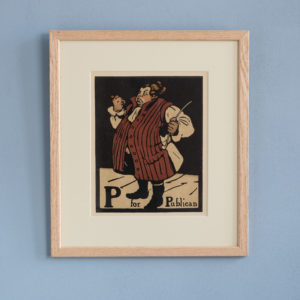
An Alphabet by William Nicholson, P for Publican,
£400 eachAn Alphabet by William Nicholson, P for Publican,
Nicholson was recommended by his friend, James McNeil Whistler to the publishers Heinemann as an original and expert wood-cut artist. The relationship with the publisher was highly successful, establishing Nicholson’s reputation as an illustrator. Between 1897 and 1900 he illustrated five works: An Alphabet, An Almanac of Twelve Sports, Twelve Portraits, London Types, and The Square Book of Animals.£400 each -
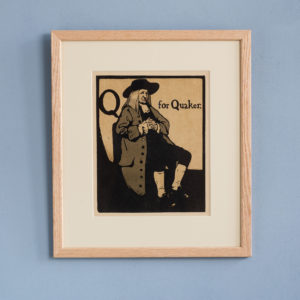
An Alphabet by William Nicholson, Q for Quaker,
£400 eachAn Alphabet by William Nicholson, Q for Quaker,
Nicholson was recommended by his friend, James McNeil Whistler to the publishers Heinemann as an original and expert wood-cut artist. The relationship with the publisher was highly successful, establishing Nicholson’s reputation as an illustrator. Between 1897 and 1900 he illustrated five works: An Alphabet, An Almanac of Twelve Sports, Twelve Portraits, London Types, and The Square Book of Animals.£400 each -

An Alphabet by William Nicholson, R is for Robber,
£400 eachAn Alphabet by William Nicholson, R is for Robber,
Nicholson was recommended by his friend, James McNeil Whistler to the publishers Heinemann as an original and expert wood-cut artist. The relationship with the publisher was highly successful, establishing Nicholson’s reputation as an illustrator. Between 1897 and 1900 he illustrated five works: An Alphabet, An Almanac of Twelve Sports, Twelve Portraits, London Types, and The Square Book of Animals.£400 each -

An Alphabet by William Nicholson, S for Sportsman,
£400 eachAn Alphabet by William Nicholson, S for Sportsman,
Nicholson was recommended by his friend, James McNeil Whistler to the publishers Heinemann as an original and expert wood-cut artist. The relationship with the publisher was highly successful, establishing Nicholson’s reputation as an illustrator. Between 1897 and 1900 he illustrated five works: An Alphabet, An Almanac of Twelve Sports, Twelve Portraits, London Types, and The Square Book of Animals.£400 each -
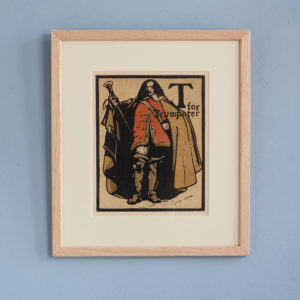
An Alphabet by William Nicholson, T for Trumpeter,
£400 eachAn Alphabet by William Nicholson, T for Trumpeter,
Nicholson was recommended by his friend, James McNeil Whistler to the publishers Heinemann as an original and expert wood-cut artist. The relationship with the publisher was highly successful, establishing Nicholson’s reputation as an illustrator. Between 1897 and 1900 he illustrated five works: An Alphabet, An Almanac of Twelve Sports, Twelve Portraits, London Types, and The Square Book of Animals.£400 each -
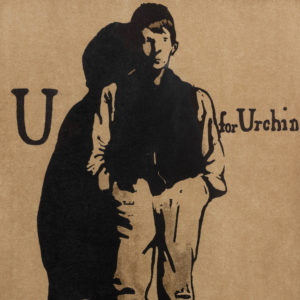
An Alphabet by William Nicholson, U for Urchin,
£400 eachAn Alphabet by William Nicholson, U for Urchin,
Nicholson was recommended by his friend, James McNeil Whistler to the publishers Heinemann as an original and expert wood-cut artist. The relationship with the publisher was highly successful, establishing Nicholson’s reputation as an illustrator. Between 1897 and 1900 he illustrated five works: An Alphabet, An Almanac of Twelve Sports, Twelve Portraits, London Types, and The Square Book of Animals.£400 each -
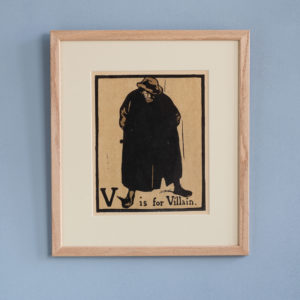
An Alphabet by William Nicholson, V is for Villain,
£400 eachAn Alphabet by William Nicholson, V is for Villain,
Nicholson was recommended by his friend, James McNeil Whistler to the publishers Heinemann as an original and expert wood-cut artist. The relationship with the publisher was highly successful, establishing Nicholson’s reputation as an illustrator. Between 1897 and 1900 he illustrated five works: An Alphabet, An Almanac of Twelve Sports, Twelve Portraits, London Types, and The Square Book of Animals.£400 each -
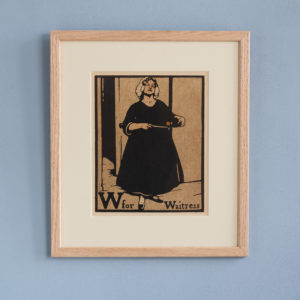
An Alphabet by William Nicholson, W for Waitress,
£400 eachAn Alphabet by William Nicholson, W for Waitress,
Nicholson was recommended by his friend, James McNeil Whistler to the publishers Heinemann as an original and expert wood-cut artist. The relationship with the publisher was highly successful, establishing Nicholson’s reputation as an illustrator. Between 1897 and 1900 he illustrated five works: An Alphabet, An Almanac of Twelve Sports, Twelve Portraits, London Types, and The Square Book of Animals.£400 each -
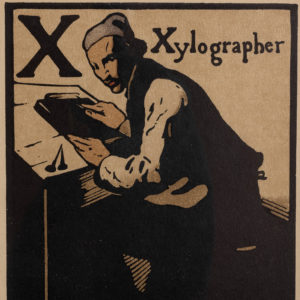
An Alphabet by William Nicholson, X Xylographer,
£400 eachAn Alphabet by William Nicholson, X Xylographer,
Nicholson was recommended by his friend, James McNeil Whistler to the publishers Heinemann as an original and expert wood-cut artist. The relationship with the publisher was highly successful, establishing Nicholson’s reputation as an illustrator. Between 1897 and 1900 he illustrated five works: An Alphabet, An Almanac of Twelve Sports, Twelve Portraits, London Types, and The Square Book of Animals.£400 each -
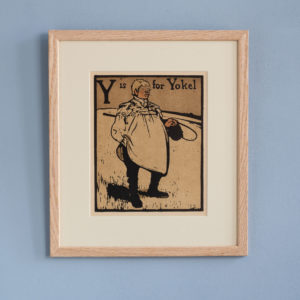
An Alphabet by William Nicholson, Y is for Yokel,
£400 eachAn Alphabet by William Nicholson, Y is for Yokel,
Nicholson was recommended by his friend, James McNeil Whistler to the publishers Heinemann as an original and expert wood-cut artist. The relationship with the publisher was highly successful, establishing Nicholson’s reputation as an illustrator. Between 1897 and 1900 he illustrated five works: An Alphabet, An Almanac of Twelve Sports, Twelve Portraits, London Types, and The Square Book of Animals.£400 each -
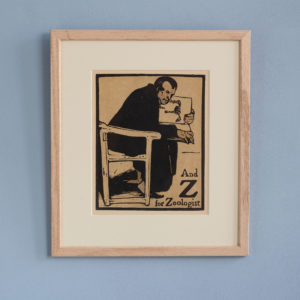
An Alphabet by William Nicholson, And Z for Zoologist,
£400 eachAn Alphabet by William Nicholson, And Z for Zoologist,
Nicholson was recommended by his friend, James McNeil Whistler to the publishers Heinemann as an original and expert wood-cut artist. The relationship with the publisher was highly successful, establishing Nicholson’s reputation as an illustrator. Between 1897 and 1900 he illustrated five works: An Alphabet, An Almanac of Twelve Sports, Twelve Portraits, London Types, and The Square Book of Animals.£400 each -
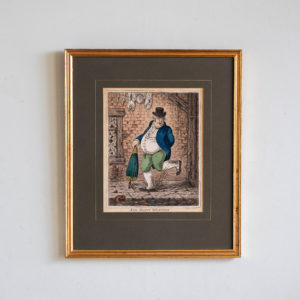
Sad Sloppy Weather
£400Sad Sloppy Weather
A framed and mounted, hand coloured engraving by the Georgian satirist James Gilray depicting a prosperous, elderly gentleman walking along a soggy pavement past mean dwellings after a rain shower. Holding a closed and reversed umbrella as a walking-stick he examines his white stockings as they become soiled with the filth of the poorly paved street.£400 -
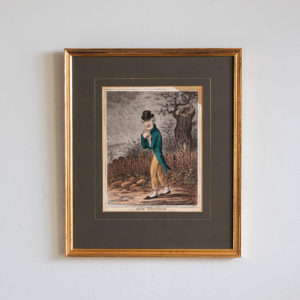
Raw Weather
£400Raw Weather
A framed and mounted, hand coloured engraving by the Georgian satirist James Gilray depicting a sour faced, skinny gentleman walking along a country road on a raw, dry, freezing, winters day. Wrapping his coat close against the biting cold he grimaces in discomfort.£400 -
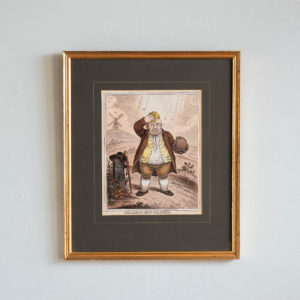
Dreadful Hot Weather
£400Dreadful Hot Weather
A framed and mounted, hand coloured engraving by the Georgian satirist James Gilray in which a corpulent city merchant pauses on the highway next to a milestone on which he has placed his hat and gold tipped walking stick. His waistcoat unbuttoned and holding his horsehair wig in his left hand he pauses to mop his brow all while being stung by insects beneath a burning sun. Though set in fields and near a windmill, the person of the merchant and the milestone likely indicate he is visiting a coutry tavern a short walk from London£400 -
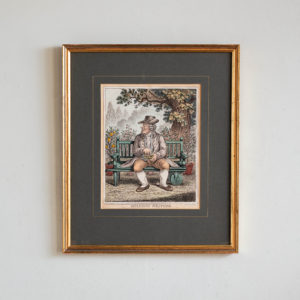
Delicious Weather
£400Delicious Weather
A framed and mounted, hand coloured engraving by the Georgian satirist James Gillray. A smartly dressed, rosy cheeked gentleman enjoys a pinch of snuff in the fine summer weather.£400 -
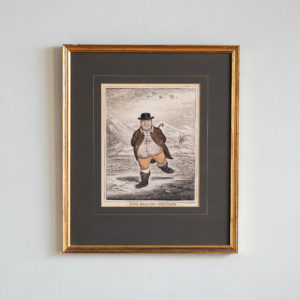
Fine Bracing Weather
£400Fine Bracing Weather
A framed and mounted, hand coloured engraving by the Georgian satirist James Gillray. A stout, well dressed, gentleman skates across a forzen pond on a clear, cold, icy early winters day.£400 -
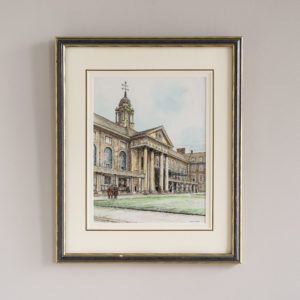
The Royal Hospital at Chelsea
£395The Royal Hospital at Chelsea
A signed watercolour and black-line pen drawing by the painter, printmaker and illustraor Hubert Williams showing the central portico of the north block of the Royal Hospital at Chelsea. Mounted and framed in an original black and gilt Hogarth Frame.£395 -
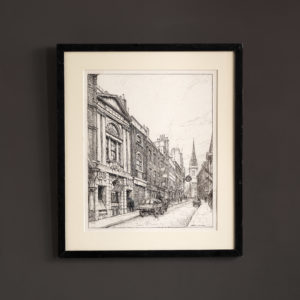
Porters Hall, by Hubert John Williams.
£395Porters Hall, by Hubert John Williams.
Hubert John Williams (1905-1989). Portrait, landscape and architectural painter, etcher and illustrator. Williams was born in Beckenham, Kent in 1905 and later studied at the Royal Academy Schools where he was awarded the Landseer Scholarship for 1928. He also attended the St Martins School of Art and the L.C.C. Schools. Between 1926 and 1939 he exhibited at the Royal Academy, Royal Scottish Academy, Royal Institute of Painters in Oil, and the New English Art Club amongst others. During WWII he worked as a cartographer in the War Office, then as commercial illustrator from 1946 specialising in children's education. His work can be found in many public collections including The Imperial War Museum and Museum of London.£395 -
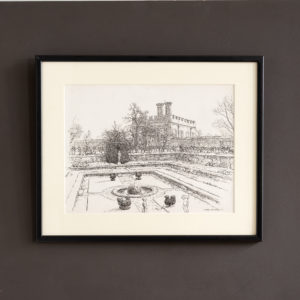
The Pond Garden, Hampton Court, by Hubert John Williams.
£395The Pond Garden, Hampton Court, by Hubert John Williams.
Hubert John Williams (1905-1989). Portrait, landscape and architectural painter, etcher and illustrator. Williams was born in Beckenham, Kent in 1905 and later studied at the Royal Academy Schools where he was awarded the Landseer Scholarship for 1928. He also attended the St Martins School of Art and the L.C.C. Schools. Between 1926 and 1939 he exhibited at the Royal Academy, Royal Scottish Academy, Royal Institute of Painters in Oil, and the New English Art Club amongst others. During WWII he worked as a cartographer in the War Office, then as commercial illustrator from 1946 specialising in children's education. His work can be found in many public collections including The Imperial War Museum and Museum of London.£395 -
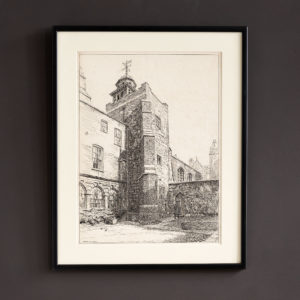
The Charterhouse, by Hubert John Williams.
£395The Charterhouse, by Hubert John Williams.
Hubert John Williams (1905-1989). Portrait, landscape and architectural painter, etcher and illustrator. Williams was born in Beckenham, Kent in 1905 and later studied at the Royal Academy Schools where he was awarded the Landseer Scholarship for 1928. He also attended the St Martins School of Art and the L.C.C. Schools. Between 1926 and 1939 he exhibited at the Royal Academy, Royal Scottish Academy, Royal Institute of Painters in Oil, and the New English Art Club amongst others. During WWII he worked as a cartographer in the War Office, then as commercial illustrator from 1946 specialising in children's education. His work can be found in many public collections including The Imperial War Museum and Museum of London.£395 -
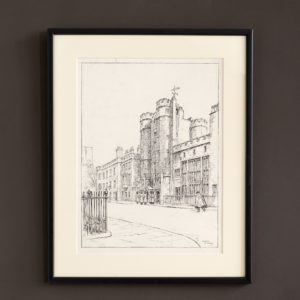
St. James Palace, by Hubert John Williams.
£395St. James Palace, by Hubert John Williams.
Hubert John Williams (1905-1989). Portrait, landscape and architectural painter, etcher and illustrator. Williams was born in Beckenham, Kent in 1905 and later studied at the Royal Academy Schools where he was awarded the Landseer Scholarship for 1928. He also attended the St Martins School of Art and the L.C.C. Schools. Between 1926 and 1939 he exhibited at the Royal Academy, Royal Scottish Academy, Royal Institute of Painters in Oil, and the New English Art Club amongst others. During WWII he worked as a cartographer in the War Office, then as commercial illustrator from 1946 specialising in children's education. His work can be found in many public collections including The Imperial War Museum and Museum of London.£395 -
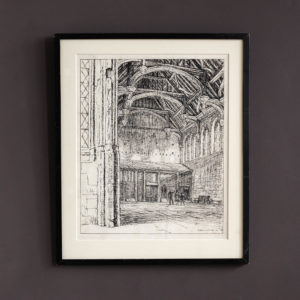
Eltham Palace, by Hubert John Williams.
£395Eltham Palace, by Hubert John Williams.
Hubert John Williams (1905-1989). Portrait, landscape and architectural painter, etcher and illustrator. Williams was born in Beckenham, Kent in 1905 and later studied at the Royal Academy Schools where he was awarded the Landseer Scholarship for 1928. He also attended the St Martins School of Art and the L.C.C. Schools. Between 1926 and 1939 he exhibited at the Royal Academy, Royal Scottish Academy, Royal Institute of Painters in Oil, and the New English Art Club amongst others. During WWII he worked as a cartographer in the War Office, then as commercial illustrator from 1946 specialising in children's education. His work can be found in many public collections including The Imperial War Museum and Museum of London.£395 -
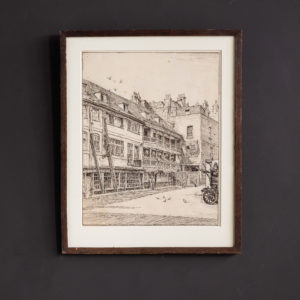
The George Inn, Borough High Street, by Hubert John Williams.
£395The George Inn, Borough High Street, by Hubert John Williams.
Hubert John Williams (1905-1989). Portrait, landscape and architectural painter, etcher and illustrator. Williams was born in Beckenham, Kent in 1905 and later studied at the Royal Academy Schools where he was awarded the Landseer Scholarship for 1928. He also attended the St Martins School of Art and the L.C.C. Schools. Between 1926 and 1939 he exhibited at the Royal Academy, Royal Scottish Academy, Royal Institute of Painters in Oil, and the New English Art Club amongst others. During WWII he worked as a cartographer in the War Office, then as commercial illustrator from 1946 specialising in children's education. His work can be found in many public collections including The Imperial War Museum and Museum of London.£395 -
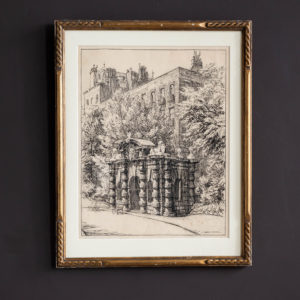
The York Watergate by Hubert John Williams.
£395The York Watergate by Hubert John Williams.
Hubert John Williams (1905-1989). Portrait, landscape and architectural painter, etcher and illustrator. Williams was born in Beckenham, Kent in 1905 and later studied at the Royal Academy Schools where he was awarded the Landseer Scholarship for 1928. He also attended the St Martins School of Art and the L.C.C. Schools. Between 1926 and 1939 he exhibited at the Royal Academy, Royal Scottish Academy, Royal Institute of Painters in Oil, and the New English Art Club amongst others. During WWII he worked as a cartographer in the War Office, then as commercial illustrator from 1946 specialising in children's education. His work can be found in many public collections including The Imperial War Museum and Museum of London.£395 -

The Blackheath Golfer
£395The Blackheath Golfer
A framed colour mezzotint on wove paper by Valentine Green after a painting by Lemuel Abbott showing William Innes (1760-1803) captain of the Society of Golfers at Blackheath, now known as Royal Blackheath Golf Club.£395 -
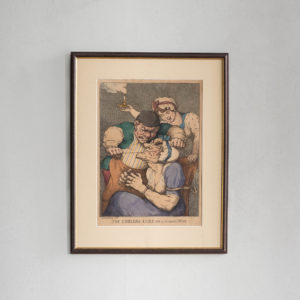
The Cobbler’s Cure for a Scolding Wife
£395The Cobbler’s Cure for a Scolding Wife
A framed, hand-colored etching by Thomas Rowlandson, published by Thomas Tegg. A study in human savagery. A cobbler stands over his wife, a grimacing virago who is tied to a chair with her wrists bound. With his awl between his teeth he pulls at the thread with which he is stitching up her mouth. A buxom young woman leans delightedly over the pair, lighting the work with a small candle. Rowlandson was a chronicler of London life both low and high. Less inclined to political comment than his contemporaries Gilray and Cruikshank he chose instead to focus of the foibles, fancies and failings of common society. His drawings were always harsh and frequently grotesque, even repulsive. The figures in his work are rarely, if ever, held up for our admiration but rather in accordance with his maxim of 1802 that "Man is the only creature endowed with the power of laughter, is he not also the only one that deserves to be laughed at?" Rowlandson's designs were usually executed in outline with the reed-pen, and delicately washed with colour. They were then etched by the artist on the copper, and afterwards aqua-tinted usually by a professional engraver, the impressions being finally coloured by hand.£395 -
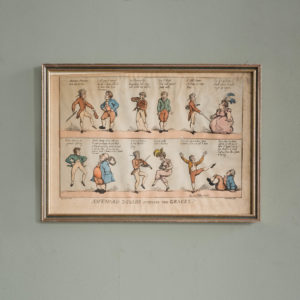
Awkward Squads Studying the Graces
£395Awkward Squads Studying the Graces
A framed, hand-colored etching by Thomas Rowlandson after G. M. Woodward, published by Thomas Tegg. Six comic, caricatured society types are cajoled and corrected by French dancing masters into performing the steps of a fashionable new dance. By the late 18th Century the term 'awkward squad' had passed from military cant into common usage as a description of a group of raw recruits incapable of understanding discipline or not yet sufficiently trained or disciplined to properly carry out their duties. Here Rowlandson, in one of his favourite recurring themes, lampoons the modish aspirations of the would-be fashionable set as they are 'drilled' by their hired dancing masters.£395 -
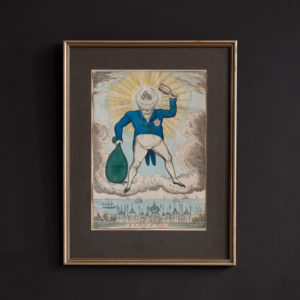
A total Eclipse, or The Moon passing the Sun’s disc
£380A total Eclipse, or The Moon passing the Sun’s disc
Hand coloured line engraving by John Fairburn. King George IV's star is eclipsed by the crecent moon of Catherine of Brunswick while suspended in the sky over the Brighton Pavillion. In his right hand he holds a sack full of slanders. A commentary on the acrimonious public divorce of the King and the Queen Consort in the 1820s;£380 -
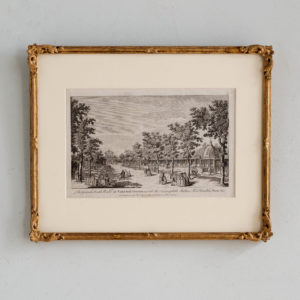
The Grand South Walk in Vaux-Hall Gardens, with the Triumphal Arches, Mr Handels Statue, &c.
£380 -
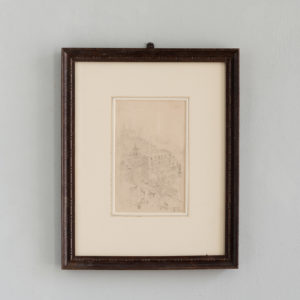
William Lionel Wyllie, The Coal Exchange from the Monument,
£380William Lionel Wyllie, The Coal Exchange from the Monument,
Pencil sketch by acclaimed marine artist William Lionel Wyllie. Initialed W.L.W. framed.£380 -
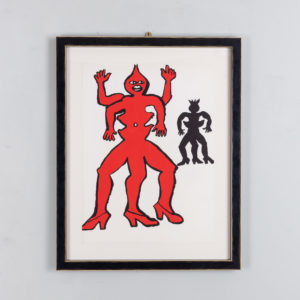
Alexander Calder lithograph from the Crags and Critters series
£380Alexander Calder lithograph from the Crags and Critters series
Published for 'Derrière le Miroir' in 1975. Framed In October 1945, the French art dealer Aimé Maeght opened his art gallery at 13 Rue de Téhéran in Paris. His magazine 'Derrière le Miroir' was created in October 1946 (n°1) and published without interruption until 1982 (n°253). Its original articles and illustrations by the gallery artists were famous at the time. The magazine covered only the artists exhibited by Maeght gallery either through personal or group exhibitions.£380 -
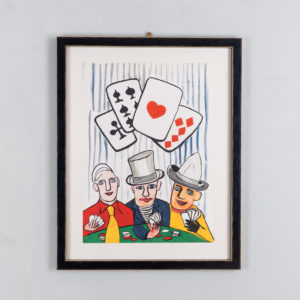
Alexander Calder lithograph of Three Card Players
£380Alexander Calder lithograph of Three Card Players
Published for 'Derrière le Miroir' in 1975. Framed In October 1945, the French art dealer Aimé Maeght opened his art gallery at 13 Rue de Téhéran in Paris. His magazine 'Derrière le Miroir' was created in October 1946 (n°1) and published without interruption until 1982 (n°253). Its original articles and illustrations by the gallery artists were famous at the time. The magazine covered only the artists exhibited by Maeght gallery either through personal or group exhibitions.£380 -
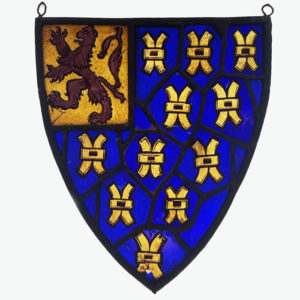
An armorial leaded and stained glass hanger,
£375An armorial leaded and stained glass hanger,
a shield shaped light, the top quarter with a lion rampant, with a field of gold devices on blue, hung from wire loops£375 -

An armorial leaded and stained glass hanger,
£375An armorial leaded and stained glass hanger,
a shield shaped light, a bar with three gold stars to the top, a white chevron with three Maltese crosses and a trio of lion heads on a claret field, hung from wire loops£375 -
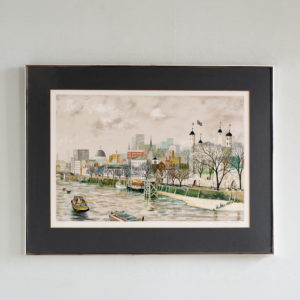
Tower of London,
£375Tower of London,
Mounted and framed, coloured lithorgraph by the pos war artist and printmaker Jeremy King showing the Tower of London from Tower Bridge.£375 -
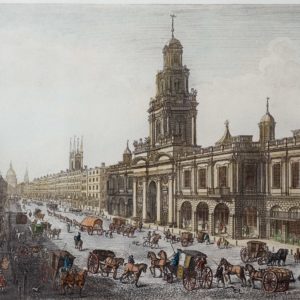
A View of the Royal Exchange London
£370A View of the Royal Exchange London
A framed and mounted hand-coloured engraving showing the Royal Exchange in its second form as designed and built by the architect Edward Jarman in 1669.£370 -
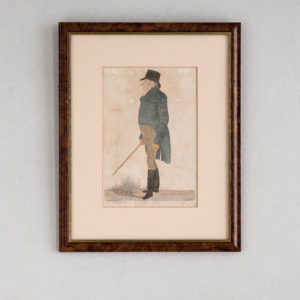
A View from the Old South Sea House
£370A View from the Old South Sea House
A hand-coloured etching by the Regency satirist Richard Dighton showing the brewer James Curtis. Richard Dighton was the son and apprentice of another noted caricaturist Robert Dighton and brother of the battle-scene painter Denis Dighton. The works of Robert and Richard Dighton are regarded as predecessors of the Vanity Fair style of the late nineteenth century. The series of portraits of City and West End characters to which this etching belongs was started in 1817 and Dighton would go on to publish a number of etchings during the next decade before retiring early to Cheltenham. This edition, of 1824, was printed by Thomas McLean Printseller & Publisher at 26 Haymarket, on the eastern side just north of Panton Street. The subject of the print, James Curtis, was a prominent and prosperous London brewer of the early 19th Century and his portrait, painted by Thomas Lawrence, now hangs in the Manchester Art Gallery. The Old South Sea House mentioned was located on the Threadneedle Street corner of Bishopsgate. The back of it apparently burned down in 1826 and was subsequently rebuilt. The building was the headquarters of the South Sea Company. Incorporated in 1711, the company was assigned a monopoly on British trade with Spanish America but, when that failed, it embarked upon a speculative scheme that ended in the economic collapse known as the ‘South Sea Bubble’ which saw many investors ruined. The building was partly remodeled in the 1850s and was eventually demolished at the end of the 19th century£370 -
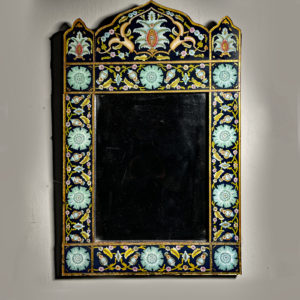
A Moorish reverse painted glass framed mirror
£365A Moorish reverse painted glass framed mirror
the rectangular plate within a glass frame with an arched cresting and painted with flowerheads and scrolling plant forms within a trellis design,£365 -
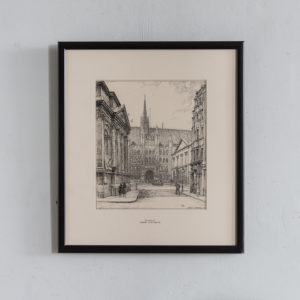
Guildhall by Hubert Williams (1905-1989)
£365Guildhall by Hubert Williams (1905-1989)
Pen & Ink drawing by Hubert Williams beautifully capturing the street life of the late 1920's. Signed. Framed£365 -
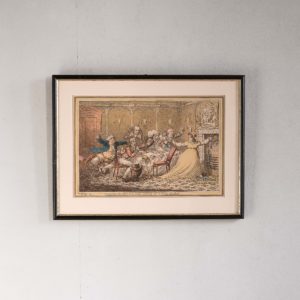
Company shocked at a lady getting up to ring the bell,
£360Company shocked at a lady getting up to ring the bell,
A hand-coloured satirical etching by James Gillray, Published by Hannah Humphrey. Five men are depicted courting a wealthy widow in her luxuriously furnished breakfast parlour over boiled eggs bread and muffins. The widow has risen from her chair to pull a bell-pull while frantic efforts of the suitors to stop her have produced a sequence of disasters. Published by Gillray's long-time and eventual exclusive publisher, Hannah Humphrey. Mrs Humphrey was the sister of engraver William Humphrey and became not only an independent businesswoman in Georgian London but London's leading seller of caricature prints. She began publishing prints in the 1770s at a premises on St Martin’s Lane before moving, first to Old Bond Street, then New Bond Street before finally settling at 27 St James’s Street. James Gillray lodged with Mrs Humphrey for twenty tears from 1791 and although some suspected an illicit relationship it was in all probability a commercial and platonic friendship. Mrs Humphrey cared for Gillray as his sight failed him and later tended to him during the alcohol induced madness of his last five years of life.£360 -
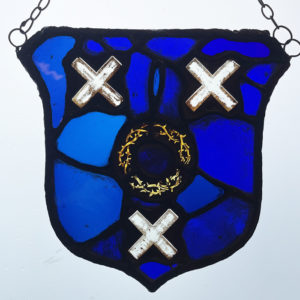
An armorial leaded and stained glass hanger,
£355An armorial leaded and stained glass hanger,
a shield shaped light with a trio of Crux Decussata centred with a delicately painted crown of thorns on a blue ground, hung from wire loops£355 -
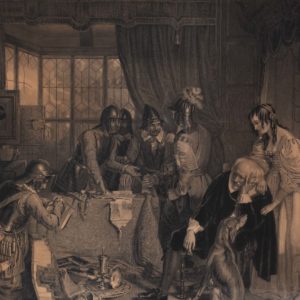
Pillage and Destruction of Basing House, Hants,
£350Pillage and Destruction of Basing House, Hants,
A Mid Victorian engraving by the London artist and printmaker John George Murray after an original oil painting by Charles Landseer showing the plundering of Basing House during the English Civil Wars. Mounted and framed in a walnut ogee profile with foliated gilt slip.£350 -
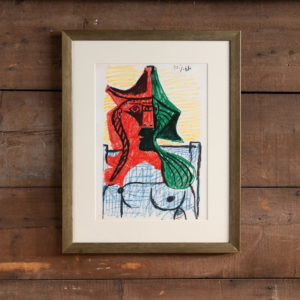
Pablo Picasso, Lithograph of a Bather Study of Edouard Manet’s, Luncheon on the the Grass. c1962
£350Pablo Picasso, Lithograph of a Bather Study of Edouard Manet’s, Luncheon on the the Grass. c1962
From 1959-1962 Pablo Picasso and his second wife Jacqueline lived at Château de Vauvenargues near Aix-en-Provence. He spent most of his time of his time on 140 drawings and 27 paintings, lino-cuts and cardboard models all on the theme of Manet’s, Le Déjeuner sur l’herbe. Manet's original painting from 1862 showing a nude woman sitting between two fully clothed men was a scandal for the time.£350 -
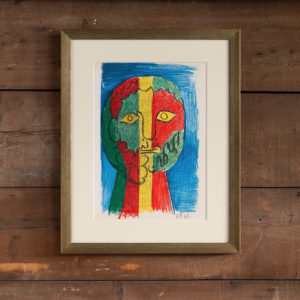
Pablo Picasso, Lithograph of a Head Study of Edouard Manet’s, Luncheon on the the Grass. c1962
£350Pablo Picasso, Lithograph of a Head Study of Edouard Manet’s, Luncheon on the the Grass. c1962
From 1959-1962 Pablo Picasso and his second wife Jacqueline lived at Château de Vauvenargues near Aix-en-Provence. He spent most of his time of his time on 140 drawings and 27 paintings, lino-cuts and cardboard models all on the theme of Manet’s, Le Déjeuner sur l’herbe. Manet's original painting from 1862 showing a nude woman sitting between two fully clothed men was a scandal for the time.£350 -
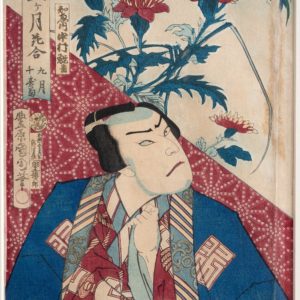
“Twelve Months of Flowers September Senju Chrysanthemum “Chienai Nakamura Suzaku”by Toyohara Kunichika
£350 -
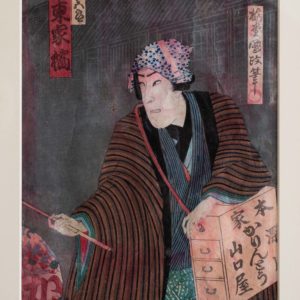
Bandō Kakitsu I, an actor by Baido Kunimasa
£350Bandō Kakitsu I, an actor by Baido Kunimasa
R/H section of a triptych depicting the actor Bandō Kakitsu I playing a karinto merchant in the play Chitose-za shin kyogen Tsuki shiraha bonji horimono.£350 -
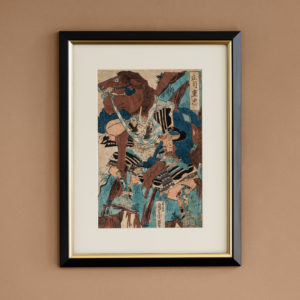
Samurai Warlord, Hatakeyama Shigetada by Utagawa Kunimune
£350Samurai Warlord, Hatakeyama Shigetada by Utagawa Kunimune
Hatakeyama Shigetada, was a warrior of the early Kamakura Period (1185-1333) famed for his virtue and bravery.£350 -
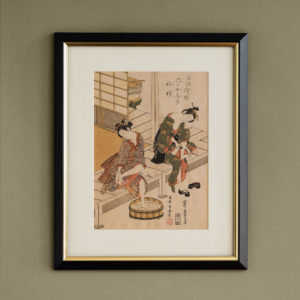
Pedicure by Torii Kiyohiro
£350Pedicure by Torii Kiyohiro
Produced by of the leading artists of the era of two-colour 'benizurie' prints, where the works are printed in pink (beni) and green, a style that peaked in the early 1740s.£350 -
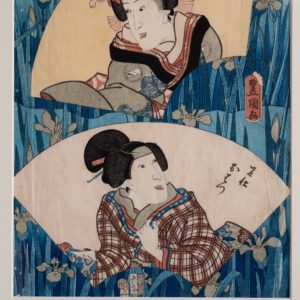
Yaoya oshichi meshitsukai o Hatsu by Utagawa Kunisada
£350Yaoya oshichi meshitsukai o Hatsu by Utagawa Kunisada
Yaoya Oshichi was a daughter of the greengrocer Tarobei, who lived in the Hongō neighborhood of Edo at the beginning of the Edo period. She was burned at the stake for attempting to commit arson. The story became the subject of joruri puppet plays.£350 -
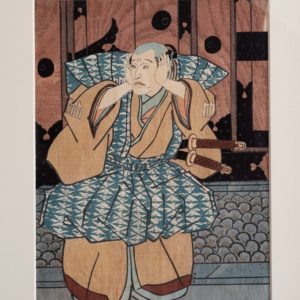
An actor from Chushingura by Utagawa Kunisada
£350An actor from Chushingura by Utagawa Kunisada
Chushingura, was Japan’s most popular kabuki play, with its origins in an event of organized mob violence in 1702, its a complex story of unquestioning loyalty, revenge, conflict, love, and punishment.£350 -
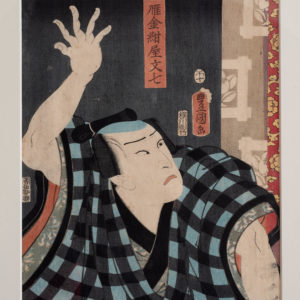
Kataoka Nizaemon VIII as Karigane Kon’ya Bunshichi by Utagawa Kunisada I (Toyokuni III)
£350Kataoka Nizaemon VIII as Karigane Kon’ya Bunshichi by Utagawa Kunisada I (Toyokuni III)
This print originally formed the R/H side from a triptych of the play, Eiyû Koko ni Yorimasa£350 -
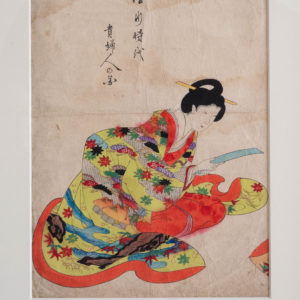
A girl reading poetry by Toyohara Chikanobu
£350A girl reading poetry by Toyohara Chikanobu
This print originally formed the R/H side of a triptych.£350 -
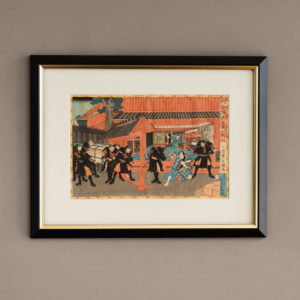
A scene from ’47 Ronin’ a Japanese Samurai Tale, 1852, after Utagawa Fusatane (active 1854-1889)
£350A scene from ’47 Ronin’ a Japanese Samurai Tale, 1852, after Utagawa Fusatane (active 1854-1889)
This print vividly depicts the famous night attack of 47 ronin, or masterless samurai, on the house of Moronao.£350 -
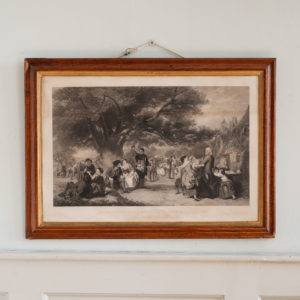
An English Merry-Making in the Olden Time – William Powell Frith
£350An English Merry-Making in the Olden Time – William Powell Frith
An large oak and gilt framed engraving by William Powell Frith showing a village celebration of the mid 17th Century taking place in the shade of a large oak tree.£350 -
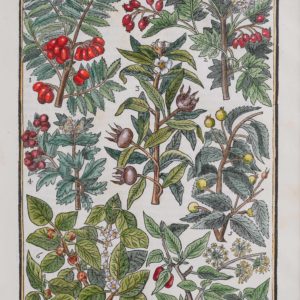
Paradisi in Sole Paradisus Terrestris by John Parkinson (1567-1650)
£350 eachParadisi in Sole Paradisus Terrestris by John Parkinson (1567-1650)
John Parkinson, born c1566, started his working life in medicine, beginning his apprenticeship to a London apothecary. He went on to become one of the most respected apothecaries in Britain. He was elected junior warden of the Society of Apothecaries in August 1620 but at the beginning of 1622, he asked for, and was granted, permission to give up his duties in the Society and then concentrated on his garden in London's Long Acre. Here he started researching and writing his first book: Paradisi in sole paradisus terrestris, and maintained close relations with other important English and Continental botanists, herbalists and plantsmen.£350 each -
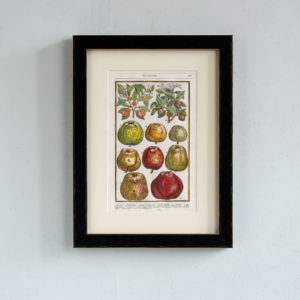
Paradisi in Sole Paradisus Terrestris by John Parkinson (1567-1650)
£350 eachParadisi in Sole Paradisus Terrestris by John Parkinson (1567-1650)
John Parkinson, born c1566, started his working life in medicine, beginning his apprenticeship to a London apothecary. He went on to become one of the most respected apothecaries in Britain. He was elected junior warden of the Society of Apothecaries in August 1620 but at the beginning of 1622, he asked for, and was granted, permission to give up his duties in the Society and then concentrated on his garden in London's Long Acre. Here he started researching and writing his first book: Paradisi in sole paradisus terrestris, and maintained close relations with other important English and Continental botanists, herbalists and plantsmen.£350 each
Featured Items
-
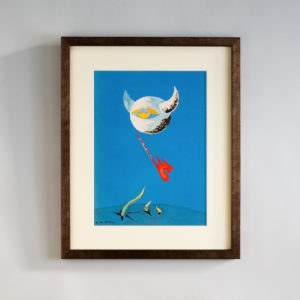
The Moon by André Masson, Verve Vol. 1 / No. 2.
£600The Moon by André Masson, Verve Vol. 1 / No. 2.
The Verve Review was a purposefully luxurious. It ran from 1937 to 1960, but with only 38 editions available, due to the high degree of design and editorial work dedicated to each issue. Each edition contained unique lithographic prints, commissioned by the editor, and each cover a double-page lithograph elaborated by one of the artists contained within. It was the brainchild of its editor Stratis Eleftheriades, a Greek National who moved to Paris in the early thirties to take part in the growing Modernist movement, writing under the name of Teriade.£600 -

The Dance, by Henri Matisse, Jan – March 1939 / No. 4.
£1,200The Dance, by Henri Matisse, Jan – March 1939 / No. 4.
The Verve Review was a purposefully luxurious. It ran from 1937 to 1960, but with only 38 editions available, due to the high degree of design and editorial work dedicated to each issue. Each edition contained unique lithographic prints, commissioned by the editor, and each cover a double-page lithograph elaborated by one of the artists contained within. It was the brainchild of its editor Stratis Eleftheriades, a Greek National who moved to Paris in the early thirties to take part in the growing Modernist movement, writing under the name of Teriade.£1,200 -
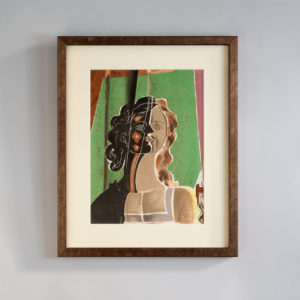
Figure by Georges Braque, Verve Vol 2 / No. 5-6.
£800Figure by Georges Braque, Verve Vol 2 / No. 5-6.
The Verve Review was a purposefully luxurious. It ran from 1937 to 1960, but with only 38 editions available, due to the high degree of design and editorial work dedicated to each issue. Each edition contained unique lithographic prints, commissioned by the editor, and each cover a double-page lithograph elaborated by one of the artists contained within. It was the brainchild of its editor Stratis Eleftheriades, a Greek National who moved to Paris in the early thirties to take part in the growing Modernist movement, writing under the name of Teriade.£800 -
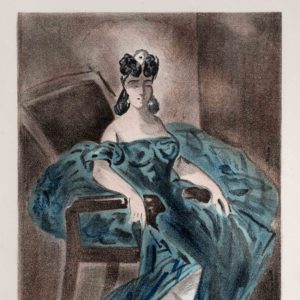
Portraits Part I by Constantin Guys, Verve Vol 2 / No. 5-6.
£500Portraits Part I by Constantin Guys, Verve Vol 2 / No. 5-6.
The Verve Review was a purposefully luxurious. It ran from 1937 to 1960, but with only 38 editions available, due to the high degree of design and editorial work dedicated to each issue. Each edition contained unique lithographic prints, commissioned by the editor, and each cover a double-page lithograph elaborated by one of the artists contained within. It was the brainchild of its editor Stratis Eleftheriades, a Greek National who moved to Paris in the early thirties to take part in the growing Modernist movement, writing under the name of Teriade.£500

